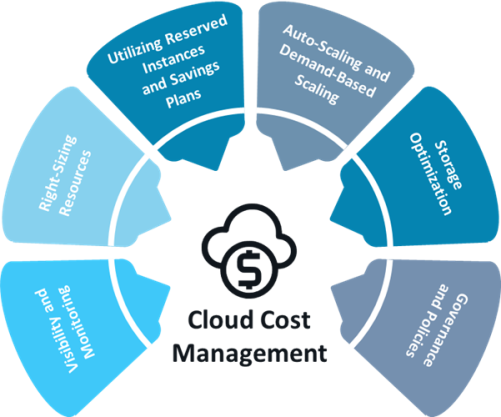Cloud spending is soaring! The cloud undoubtedly has steered an era of unmatched agility, allowing businesses to scale operations at a rapid pace and develop cutting-edge technologies. But the catch is that these benefits come at a cost, and it is easy for cloud costs to spiral out of control in the absence of effective and efficient strategies.
Cloud computing has matured as a technology, disrupting industries to better business operations. Gartner predicts that cloud computing will be an element that will be essential for competitiveness by 2028. Reshaping the way we store and manage data; cloud computing has also played a catalyst in changing the way we work and live.
Do you feel your cloud expenses are exploding and getting out of control? A survey by Everest Group found that 67% of global organizations exceed expected cloud costs, with 82% wasting over 10% of their spending. Studies also say that with effective optimization strategies, businesses can cut cloud costs by 20-30% or more. However, with the rapid adoption and accelerated use of the cloud, cloud waste has started to escalate to become a big problem for companies.
So how do companies plan to deal with problems? Well, having a fair idea about the solution is not enough. Businesses need to look for proven strategies that can tactfully address cloud spend and not just this but help businesses maximize savings. Dive into our blog to understand cloud cost challenges, proven cloud cost strategies, cloud cost optimization, and more.
What is cloud computing and why is it important for business growth
Before we start talking about the challenges concerning cloud costs let us quickly find out what cloud computing is and why it is important for business growth.
Cloud computing is a transformative IT paradigm. On the technical front, it is a network of remote servers managed by third parties that can be easily accessed via the Internet.
By migrating to the cloud, businesses no longer have the need to make bank-breaking investments in infrastructure and can store data, run business applications, develop software, and a lot more, on a subscription model. With the cloud in action, businesses no longer need to buy or maintain in-house or on-premises servers. In fact, the cloud proves to be a more cost-efficient and effective bet for businesses.
To streamline your cloud journey, you can also check out our blog which gives insights on cloud-native application development.
Understanding Cloud Services and Deployment Models
To maximize cloud computing benefits, businesses need a clear understanding of cloud service types and deployment models.
Leading cloud providers like Google Cloud, Microsoft Azure, and AWS offer services like IaaS for renting IT resources, SaaS for web-based software access, PaaS for app development, and BPaaS for automating business processes. Cloud deployment models include the public cloud (cost-effective but shared), private cloud (dedicated but costly), and hybrid cloud (a flexible mix of both).
Discover the key differences between Stream Native Cloud and Amazon MSK in our latest whitepaper to find the best fit for your business needs.
Stream Native Cloud vs Amazon MSK
Demystifying the concept of cloud cost optimization
Want to optimize your cloud bills? Then let’s begin with understanding what exactly cloud cost optimization is.
Cloud cost optimization is a concept that can be broken down into appropriate and cost-efficient cloud resources allocated to individual workloads or applications. It is an act deployed to balance elements such as performance, compliance, cost, and security requirements to ensure cloud investments don’t spur out of control and are used optimally in sync with the organizational requirements.
However, to optimize cloud costs to the best possible level, it is recommended to set performance thresholds for each workload with the help of operational metrics and domain expertise. It is also important to note that cloud cost optimization is not a one-time thing, but an ongoing process, which involves adapting to changing application needs and shifting cloud pricing.
Listing down the suspects of cloud waste
Having a good idea about underlying factors that can contribute to cloud waste is extremely essential before you plan to move your business to the cloud. They serve as a foundational step towards helping businesses know what not to do. So, let’s find out what they are:
Underutilized or Idle Resources: Organizations often get over-ambitious and provide more resources than they need. This leads to idle or underutilized instances such as storage, and a series of other cloud assets. These unused resources tend to accrue costs and directly contribute to needless spending.
Lack of Visibility into Cloud Usage Pattern: Organizations often struggle with gaining visibility into their cloud usage patterns that leads to poor utilization of resources. Businesses cannot achieve visibility without clear insights that largely depend on the effective use of monitoring tools.
Intricate Pricing Models: Cloud pricing models can sometimes be complex and intricate, making it difficult for businesses to gain accuracy in predicting and managing their cloud spend. So, before signing up for cloud services it is essential to have complete knowledge about the pricing model from the cloud provider.
Shadow IT: Unauthorized cloud storage, also known as Shadow IT, can be one of the most alarming reasons to add up to hidden cloud costs. When employees happen to secure these services without IT oversight, such costs might go unnoticed, adding surprisingly high cloud bills.
Cloud Service Models: Choosing IaaS, PaaS, or SaaS impacts costs, as each offers varying levels of control and management.
Sneak-Peak into the reliable cloud cost optimization framework

Cloud cost optimization framework can be your go-to remedy to avoid additional cloud costs and maximize savings. To make this step easy, we have listed down elements that build a comprehensive cloud cost optimization framework.
Visibility and Monitoring
The first step in any cost optimization framework is establishing visibility into cloud spending. This involves using tools like AWS Cost Explorer, Azure Cost Management, or GCP Cost Management to track and analyze expenditures. Continuous monitoring helps identify cost trends and potential savings opportunities.
Right-Sizing Resources
Right-sizing involves adjusting cloud resources to match workload requirements. Regularly analyzing usage patterns and scaling resources up or down ensures that organizations only pay for what they need. This practice is vital for avoiding overprovisioning and minimizing waste.
Utilizing Reserved Instances and Savings Plans
Reserved instances and savings plans offer significant discounts compared to on-demand pricing. Organizations should assess their long-term usage patterns and commit to these plans where appropriate. This strategy helps us lock in lower rates and achieve substantial cost savings.
Auto-Scaling and Demand-Based Scaling
Implementing auto-scaling allows cloud resources to dynamically adjust based on demand. This ensures optimal resource utilization and cost efficiency, as resources are scaled up during peak times and scaled down during low-demand periods.
Storage Optimization
Effective storage management involves using the right type of storage for diverse needs, implementing data lifecycle policies, and regularly reviewing storage usage. By optimizing storage, organizations can reduce costs associated with data retention and high-performance storage options.
Governance and Policies
Establishing governance and policies is crucial for controlling cloud costs. This includes setting budgets, defining usage policies, and enforcing tagging resource standards. Governance helps prevent resource sprawl and ensures accountability.
A well-structured cloud cost optimization framework incorporates visibility and monitoring, right-sizing resources, leveraging reserved instances, implementing auto-scaling, optimizing storage, and establishing governance. By following these components, organizations can effectively manage their cloud expenditures and enhance their financial efficiency.
Top five strategies for cloud cost optimization for maximum savings

As mentioned before cloud solutions are promising and can significantly impact aspects such as maximizing the Return on Investment (ROI), ensuring financial predictability, mitigating risk, empowering innovation, and a lot more. However, without vigilant management and a realistic roadmap in place, none of this is possible. For businesses who aim to leverage the benefits cloud without overspending, we share five strategies that can prove to be game changers.
- Understand your cloud usage
Audit is an integral part of having a healthy cloud ecosystem. Therefore, conducting regular cloud audits can help curb unnecessary expenses. This exercise helps businesses get more clarity on the usage patterns, identify inefficiencies, and uncover opportunities for better use of the cloud.
On the technical front, cloud audit is a process that enables businesses to systematically review and assess the organization’s cloud infrastructure, compliance, and security controls. It is a comprehensive process that examines the cloud provider’s data access control, overall risk management strategies, and security practices. These audits can either be conducted in-house or by leveraging third-party services.
Identifying and doing away with waste is a critical part of cloud cost optimization. It is essential to understand that unused or idle resources are one of the primary reasons leading to unnecessary expenses. For instance, with the help of cloud audit, businesses can identify the glitch in time, and with corrective actions such as resizing instances, consolidation of workloads and other appropriate steps can ensure optimal use of cloud services they have signed up for.
- Optimized Resource Allocation
Right-sizing resources is a critical step when it comes to cloud cost optimization. This involves modification in terms of the size of cloud instances to be proportional to the workload requirements in a precise manner. By getting this process in the routine, it works towards monitoring resource usage patterns and performance metrics, to strike a balance and ensure that resources are neither over-provisioned nor underutilized.
Mindful implementation of options such as auto-scaling is another powerful way to optimize cloud resource allocation, as it is designed to automatically adjust the number of instances based on the demand. This step not only enhances application performance and availability but also takes care of scaling down resources, which is necessary during situations of low demand.
It is important to understand that the cloud landscape includes features such as elastic compute capacity, which demands expertise and the right use of tools to ensure migration costs don’t explode.
- Embrace a Multi-Cloud Strategy
Even though cloud computing offers an upper hand to businesses when it comes to storage and a more flexible pricing strategy, by no means is this inexpensive. Often businesses fall prey to unmanageable cloud expenses making this platform an unsustainable option.
However, adopting a multi-cloud strategy offers impactful advantages, like cost benefits, and avoiding the limitations associated with vendor-lock-in. By strategically distributing workloads across different cloud service providers (CSPs), businesses can have their best bet in the cloud, by leveraging the best features and pricing models offered by CSPs. Another big advantage of a multi-cloud strategy is that it provides businesses with the best possible flexibility and helps them avoid dependency on a single-provider ecosystem.
- Implement a chargeback model
Businesses using the cloud must take charge of what they consume. This proves helpful in creating forecasts and pursuing optimization opportunities. To begin with, businesses can work on developing a resource tagging model to implement a powerful chargeback model. This is a model closely related to attributing the costs of cloud services back to the respective departments/business units (BUs), that are using them. It is an excellent way of keeping a check on if the parts of the organization are using these services in the best possible manner.
With a chargeback model in place, costs of compute instances used by the say the marketing team, sales team, or development folks will be billed back to them.
- Use the right sourcing, pricing, and discounting model
- Select the Right Sourcing Model: To achieve maximum cloud cost savings, it’s essential to choose a sourcing model that fits your organization’s needs. Consider whether allocation-based or consumption-based services are more suitable, as this decision will significantly impact your overall cloud expenses and resource management.
- Leverage Strategic Pricing and Discounting: Making the most of cloud pricing options requires a thoughtful approach. Reserved instances, for example, offer valuable discounts when you commit to an upfront payment over a set period, typically one or three years. To maximize savings, carefully analyze your historical usage data to make an informed decision on the duration and volume of reserved instances. Both Microsoft Azure (through Azure Reserved VM Instances) and Amazon Web Services (via AWS Management Console) provide various reserved instance pricing models, allowing you to lock in lower rates and optimize your cloud spending based on your organization’s specific needs.
Parting Thoughts
“Companies identify the absence of clear insight into cloud usage and ineffectiveness as the main cause of excessive spending on cloud services. This absence of clarity poses difficulties in monitoring and enhancing the utilization of cloud resources, resulting in inefficiencies and avoidable costs.” – Anonymous.
This quote focuses on the importance of transparency while businesses sign up for cloud computing services.
Working with cloud partners benefits the organization in several ways. Right from getting rid of the hardware and software to having centralized data security, to easy access anywhere at any time over the internet, cloud computing happens to be a boon for businesses of every size and shape.
In this ever-changing digital era, cloud computing is a thing for sustainable growth and advantage. However, to make the cloud an asset and not a liability, having a close eye on cloud spend is a must. We hope the strategies shared above will be of value while driving your cloud experience.
Calsoft has been in the technology business for over 2 decades and has embraced the goodness of the cloud. With a complete arsenal of cloud engineering solutions, we have helped businesses of all sizes and shapes to gain a competitive edge. If your business is grappling with mismanaged cloud costs or wants to enhance your cloud experience, check out our offerings.






